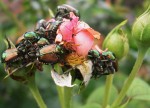
There are four common pests of roses. They can cause a lot of trouble but once identified can usually be controlled.
 Aphids
Aphids
Your are likely to recognize an aphid attach by the sticky honey dew that attracts both ants and the growth of black sooty mold. The aphids produce this substance as they suck the sap out of the food carrying cells (phloem) of the flower buds and new growth. The result of the aphid’s activity is usually stunted and/or distorted leaves and buds, rarely the death of the plant. Most aphid attacks can be washed away by a strong jet of water from a house. Lady beetles and other beneficial insects usually do away with aphids before the aphid population gets out of hand but there are chemical means of dealing with them such as Malathion.
 Thrips
Thrips
These tiny insects are carried by the wind and feed on the petals in rose buds causing them to be misshaped and discolored. They are especially partial to roses with pale flowers, pink, yellow and white. They are only 1/25” long and are usually produce brown or silver spots, or brown edges on the petals. They have a short life cycle (40 days) so many generations of thrips are produced in the course of the summer. The good news is that although they ruin the appearance of the flowers they attack, they do not have a lasting effect on the plant as a whole. Control can be difficult because thrips hide inside the buds but insecticides and insecticidal soaps may help control them. Because they reproduce so rapidly they may develop resistance to insecticides so prevention is important. Since they over winter in debris remove infected flowers immediately and clean up litter underneath the rose bushes.
 Spider Mites
Spider Mites
When the summer is dry and hot the spider mites thrive. They are almost microscopic but may be seen by shaking an infected leaf over a white piece of paper. The mites will look like specks of pepper. They feed on the underside of older leaves and may form a fine webbing. When the infestation severe the leaves may turn brown and fall off. A strong spray of water applied daily to leaves may reduce the infestation but this is a tricky remedy as the mites are are the underside of the leaves. In addition, wetting the leaves may lead to fungal problems on the leaves. Insecticidal soaps, summer oil, and as a last resort, a miticide, are usually effective.
 Japanese Beetles
Japanese Beetles
If you live east of the Mississippi River you probably have experienced the ravages of of Japanese beetles, those shiny winged insects that can ruin flowers and skeletonize leaves. Some years are worse than others and there is no way of predicting what years will bring problems. The larvae live in soil and can be reduced in number by applying nematodes or milky spore (a bacterium) that feed on the white grubs. Once they hatch control is difficult. Picking them off the plants several times a day until the population declines and putting them in a can of soapy water is the best way to save your bushes. Traps are not recommended because they attract the beetles from the entire neighborhood. Sevin is effective but since it is a broad spectrum insecticide it kills the “good guys” too.
For more information read my post on Japanese beetles.
The best way to control pests is to have a program of prevention. This involves good cultural practices meaning good soil, adequate water, and proper nutrition. Spacing out the plants and good pruning increases air circulation and benefits the over all health of the rose bush. Healthy bushes are less likely to become infected or suffer the effects of infection than stressed plants so the first line of defense should be the application of good cultivation techniques.
